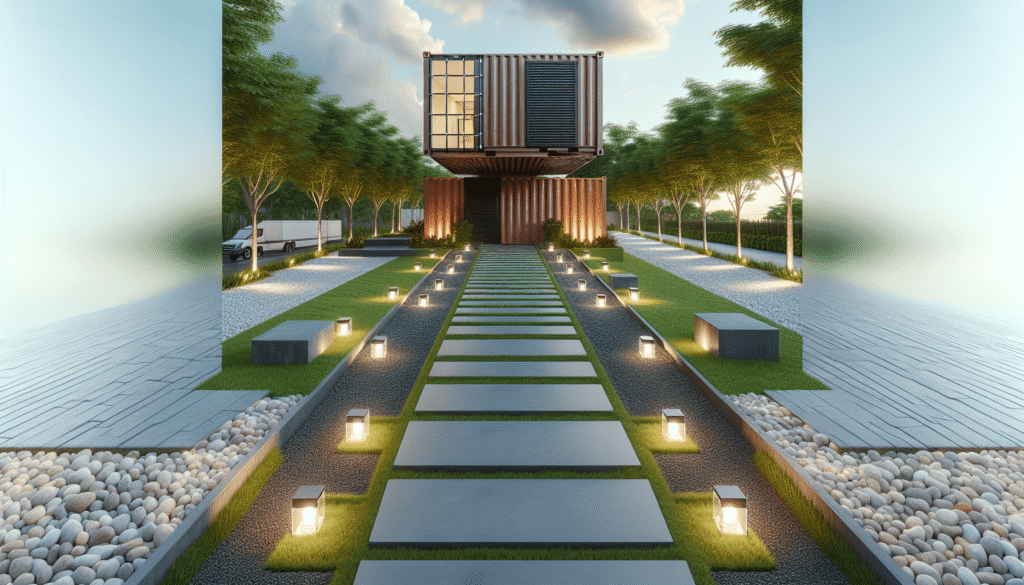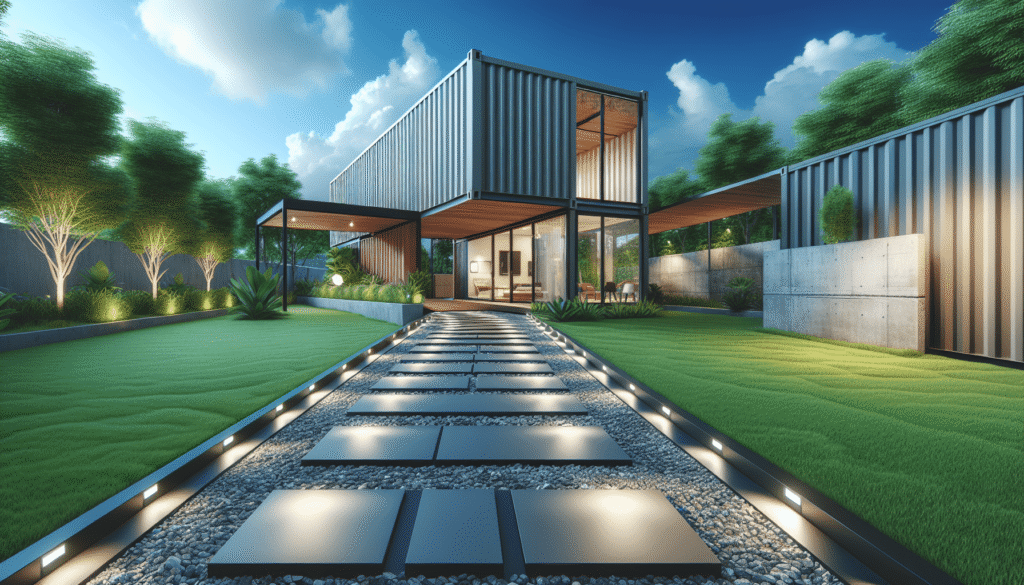Have you ever considered how a thoughtfully designed pathway could transform your shipping container home? Pathways are more than just a means to get from one place to another; they are the veins that bring life to the entire property, guiding guests while enhancing your home’s aesthetic appeal. Let’s explore how modern design principles can help you craft inviting and functional pathways for your unique living space.
Understanding the Essence of Pathways
Pathways are crucial elements in landscape design, often underestimated but never insignificant. They serve functional purposes, such as directing foot traffic and connecting spaces, while also offering an opportunity to express personal style and enhance the home’s curb appeal. For shipping container homes, which often embody modernity and sustainability, the pathway design can serve as a seamless extension of these concepts.
The Significance of Pathways
In a physical sense, pathways are the connectors between two points in your outdoor space. However, they also serve a metaphorical role, introducing visitors to the narrative of your home. By choosing materials, designs, and layouts that complement your shipping container home, you can cultivate an atmosphere that is both welcoming and innovative.
Why Container Homes and Pathways Pair Well
Shipping container homes are known for their modern, industrial aesthetic. Therefore, the pathways you choose should reflect and augment these qualities. A well-crafted pathway can harmonize with the linear, clean lines characteristic of container homes, creating a cohesive and striking visual experience.
Material Choices for Modern Pathways
Choosing the right materials for your pathways is fundamental, not only for aesthetics but for durability and maintenance. Modern pathways often employ materials that offer clean lines, durability, and environmental sustainability.
Natural Stone
Natural stone offers a timeless appeal and can be used to create elegant pathways that are both durable and aesthetically pleasing. The irregular shapes and varied colors can add a touch of sophistication and blend well with the natural surroundings of a container home.
Concrete
Concrete is a versatile and modern material that can be molded into various shapes and textures. It offers durability and can be colored or stained to match the exterior of your shipping container home. Its clean, minimalist look fits perfectly with industrial aesthetics.
Gravel
Gravel is an economical and easy-to-install option that provides excellent drainage. It works well for informal pathways, and its natural look complements the earthy tones often found in and around container homes. Gravel pathways can have a casual yet refined feel when edged with metal or wooden borders.
Composite Materials
Environmentally friendly and durable, composite materials are made of recycled wood fiber and plastic. They’re a fantastic option for those who want a modern look while also preferring low maintenance and sustainability.

Design Ideas for Modern Pathways
Creating the pathway that suits your shipping container home involves more than just choosing materials. Consider the design and layout to ensure it complements the structure and enhances the overall environment.
Minimalist Walkways
Minimalism is inherently linked with modern design. A simple, straight pathway made with concrete or smooth stones can emphasize the elegance of simplicity, highlighting the geometric shapes of a container home.
Winding Paths
Winding pathways can create a sense of exploration and intrigue. Using stones or stamped concrete to create gentle curves can soften the robust, industrial feel of a shipping container home, blending the manmade with the organic.
Symmetrical Designs
For those who appreciate order and balance, symmetrical pathways leading to the entrance of your home can create a grand, welcoming effect. Use symmetrical planting or lighting alongside hard materials like paving stones or bricks.
Integrating Technology
Incorporating smart technology into your pathway design — such as solar-powered lights or motion sensors — can provide both functionality and modern appeal, ensuring safe navigation during nighttime while also spotlighting key features of your landscape.
Maintenance Considerations
Regular maintenance ensures pathways remain safe and attractive. Maintenance needs can vary greatly depending on the materials chosen, so understanding these requirements will help you make informed decisions.
Seasonal Care
Different seasons can bring varying degrees of maintenance challenges. In winter, snow and ice need clearing, whereas in autumn, fallen leaves should be removed to prevent decay and stains. Regular sweeping and occasional power washing in the warmer months keep pathways looking pristine.
Material-Specific Upkeep
Each material comes with unique care instructions. For instance, sealed stone requires reapplication of a protective sealant periodically. Gravel paths need occasional topping up where the rocks may disperse, and weeds must be managed. Concrete pathways may need cracks filled to prevent them from enlarging.
Preventive Measures
Taking preventive measures can save time and money in the long run. Installing proper drainage helps prevent water accumulation and damage. Regularly inspecting paths will help identify potential issues before they become major problems, ensuring longevity and safety.

Incorporating Landscaping Features
Enhancing pathways with surrounding landscaping can elevate your home’s visual and environmental impact. The integration of greenery, lighting, and decorative elements contributes significantly to a pathway’s allure.
Green Borders
Aligning pathways with plants can integrate the pathway with your landscape, creating a transition from hardscape to softscape. Low-maintenance, native plants are ideal as they require less water and care while supporting local biodiversity.
Artistic Elements
Pathways can be canvases for creative expression. Incorporate mosaics, engraved stones, or artistic paving patterns to reflect personal style and make your paths unique. These elements can serve as conversation starters and highlight your pathway as a focal point in the garden.
Lighting
Effective use of lighting not only enhances safety but also amplifies beauty. Place solar-powered LED lights along the pathway, spotlights to emphasize focal areas, or hang string lights for a whimsical touch. Consider using dimmable or color-changing lights to easily alter the ambience to suit the occasion or mood.
Sustainable Pathway Practices
Modern pathway designs are trending towards sustainability. By incorporating eco-friendly materials and techniques, you can minimize your environmental impact while enhancing your home’s value.
Permeable Pathways
Permeable materials help manage water runoff and reduce erosion by allowing rain to seep through and nourish the surrounding soil. Options include permeable concrete, porous asphalt, or synthetic grass.
Recycled Materials
Using recycled materials, like crushed glass or reclaimed bricks, contributes to sustainability by reducing waste and using fewer natural resources. Plus, these materials can add unique textures and colors to your pathway.
Local Material Sourcing
Consider using materials sourced from your local area. This strategy reduces transportation emissions and supports local businesses. Local stones or salvaged wood also provide a connection to the cultural or geographical context of your home.
Aligning Paths with Container Home Features
Pathways do not exist in isolation. Aligning their design with the distinct features of your shipping container home can create an integrated and harmonious living environment.
Entry Focal Points
Create a welcoming entrance by aligning pathways with the main entry’s architectural elements. Match the path’s layout and materials with the container home’s color scheme or structural accents to ensure a seamless transition from outdoor to indoor spaces.
Deck and Patio Connectivity
Extend the living space of your container home through strategic pathway connectivity. Paths leading to decks or patios can encourage outdoor living and enhance the enjoyment of external spaces.
Visual Flow and Cohesion
Keep the overall aesthetic consistent by choosing pathway designs that reflect the clean lines and modern feel of a container home. Seeing a cohesive design in both the home’s structure and the landscape can create a sense of order and professionalism.
Personalized Pathway Enhancements
Every home is a unique reflection of its owner’s tastes and lifestyle. Personalizing pathways ensures they serve not only practical purposes but also contribute personal comforts and desires.
Pet-Friendly Pathways
For pet owners, designing pathways with pets in mind is a great idea. Smooth materials, like sealed concrete or synthetic grass, are gentle on paws, while fencing or hedging can safely guide pets.
Spaces for Contemplation
Create areas along your pathway for rest and reflection. Placing benches or small seating areas with views of landscape features can provide breaks in the journey and opportunities for enjoyment of the surroundings.
Environmental Interaction
Pathways can offer more than a route; they can encourage interaction with the landscape. Touch-and-smell gardens, interactive art installations, or soundscapes along the path can enhance the sensory experience of navigating your outdoor space.
Conclusion
Crafting the perfect modern pathway for your shipping container home involves a careful balance of aesthetics, functionality, and sustainability. By considering material choices, design innovations, maintenance needs, and personal touches, you introduce not only pathways but warm welcomes and lifelong journeys within your home environment. Thoughtful pathway design can remarkably transform your property, ensuring it is both a visual delight and a harmonious extension of your stylish, innovative container home.

